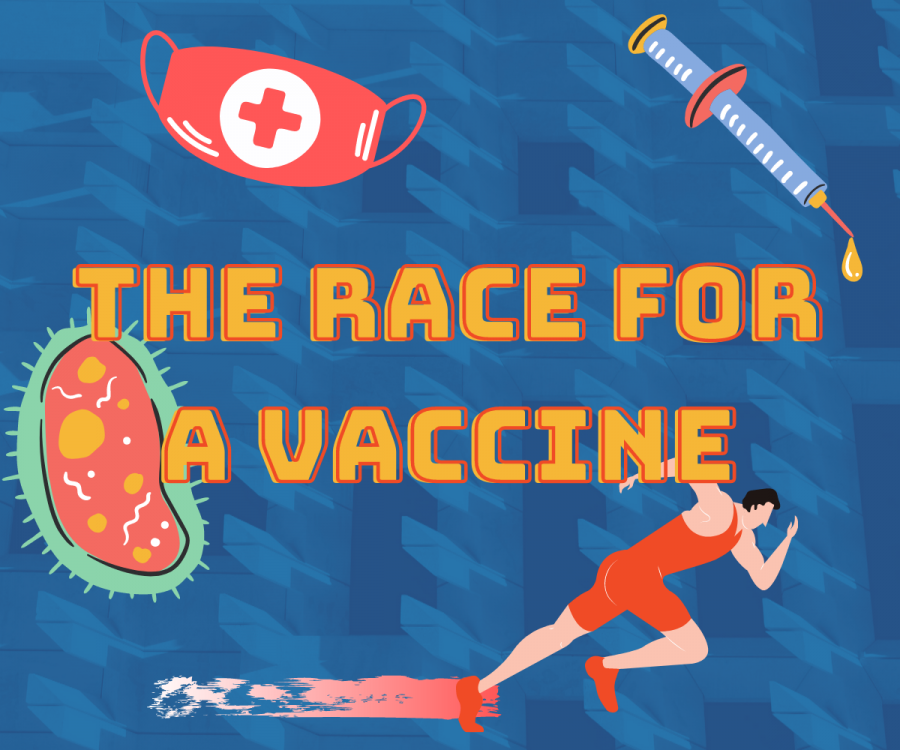The race for a vaccine
Biomedical companies around the world are racing to get past the yellow tape of safety regulation. Moderna has released information about their tests, and essential workers have been able to receive vaccinations.
All around the world, different companies have been fighting in a race to get through the stages of FDA approvals. Domestically, companies like Moderna and Pfizer have gone through stages of testing.
According to the CDC, there are several different stages to before the FDA approval and distribution can be approved. These include the Investigative New Drug application, pre-license vaccine clinical trials, Biologics License application, presentations of findings to FDA’s Vaccines and Related Biologics Advisory Committee and finally usability testing of product labeling.
“You would like to see 90, 95 percent, but I wasn’t expecting it. I thought we’d be good, but 94.5 percent is very impressive,” director of the National Institute of Allergy and Infectious Diseases Anthony Fauci said.
The Moderna vaccine, also known as mRNA-1273, is the company and trials we know the most about. They released information on how many subjects have been tested, their race, their age, and what kind of trial was performed. The testing was double-blind, meaning neither researchers nor subjects knew if they were getting the vaccine, or a saltwater injection.
“Moderna uses a synthetic version of coronavirus genetic material, called messenger RNA or mRNA, to program a person’s cells to churn out many copies of a fragment of the virus,” said New York Times reporter Denise Grady. “A synthetic version of coronavirus genetic material, called messenger RNA or mRNA, to program a person’s cells to churn out many copies of a fragment of the virus.”
The study is compiled of several important groups of minorities, because as the inspection of the COVID vaccine comes out, the more we see it showing up at a higher rate of Hispanic and Black Americans. 20% of the study was Hispanic, 10% Black, and 4% Asian. A quarter of the study population was elderly persons. The vaccine was given in two doses, 28 days apart.
“The Moderna and Pfizer mRNA vaccines, if approved, will become the first licensed products using an approach that has been thought to hold enormous promise as a tool for responding to new disease threats,” Stats News writer Matthew Herper said.
But that does not mean it’s the only vaccine out there. Internationally, other vaccines and messenger RNA companies have been working to create a vaccine that works effectively. The European Commision has created a contract with CureVac, a German biopharmaceutical company that develops messenger RNA, similar to Moderna. The European Commision is also drawing up a contract with Moderna since their press release on their study.
“The Commission has secured to date at least 1.2 billion doses and fulfils its commitment to ensuring equitable access to safe, effective and affordable vaccines,” said President of the European Commission Ursulla von der Leyen. “Not only for EU citizens but also for the world’s poorest and most vulnerable people.”
The rush to create a vaccine does have the President of the EC and others worried. Because both Moderna and Pfizer need to be stored at negative degree temperatures Fahrenheit, it may complicate the distribution process. If not regulated the vaccine would then become active. On top of that, Leyen and the companies themselves are not sure the time frame of reliability.
“We do not know at this stage which vaccines will end up being safe and effective,” Leyen said.
The US has a department that actively works against post-licensed issues: The Vaccine Adverse Event Reporting System. This system collects and analyzes information from reports that occur from vaccines that have already been manufactured and distributed.
“VAERS is not designed to determine if a vaccine caused a health problem but is especially useful for detecting unusual or unexpected patterns of adverse event reporting that might indicate a possible safety problem with a vaccine,” the VAERS website said. “This way, VAERS can provide CDC and FDA with valuable information that additional work and evaluation is necessary to further assess a possible safety concern.”
Overall, the testing is on its way through the works of safety regulations, each country going at different rates based on the precautions and requirements. As of recent, Moderna is the farthest in development domestically, and has started tests on adolescents.

